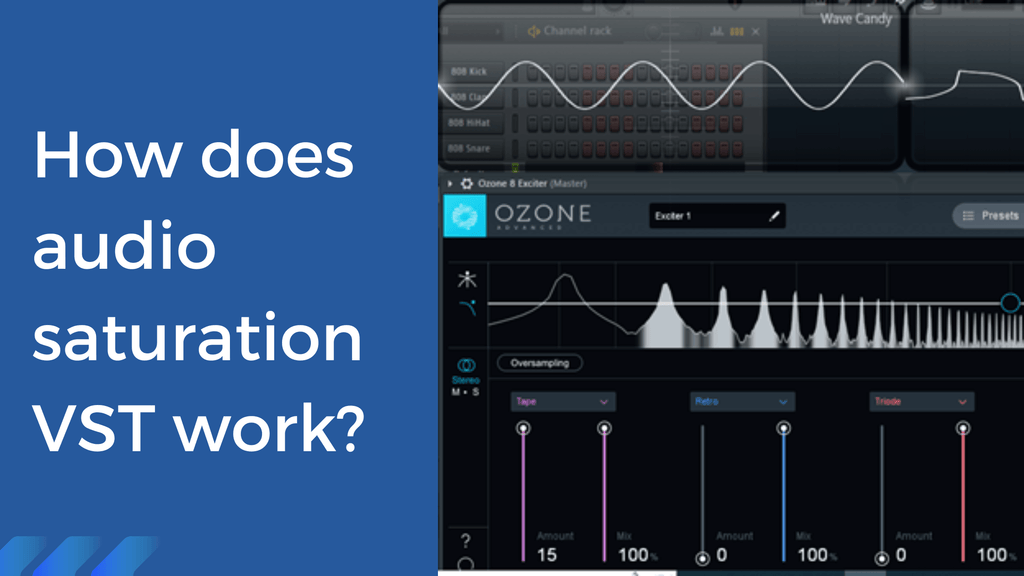How Does Audio Saturation VST Work? Explained.

Audio saturation VST is one of the most used effect plugin in audio mixing and mastering. It adds the color and quality of analog hardware such as tubes, transistors, tape, etc. It also shapes the sound, changes the tone & timbre, and tonal balance. This article will look at how exactly these saturation VSTs work.
In the process, you will also learn about the harmonics, some of the best saturation VSTs available in the market, and more. So without further delay, let's get started.
Also Read : Top 10 saturation VST Plugins
What are audio saturation VST, and how do they work?
If we have to define audio saturation, "Audio saturation is the process of inducing analog qualities of a hardware component such as a tube, tape, transistor, etc." Saturation VSTs is the plugin that performs these operations. They introduce analog behavior in digital audio.

How do these saturation VSTs work? We have two main types of saturation VSTs. First, those which induce even or odd harmonics based on a pre-defined harmonic content, Like Thickify. Second, those which simulate a physical model of a hardware component, Like Fairchild 670 VST models.
What are Even and Odd harmonics?
Every waveform, including sound are combination of many sin waves, each at a different phase, amplitude, and frequency. In synth terminology, we call these harmonics partials. The frequency of the root note is known as the fundamental or 1st harmonic; after that, each harmonic is known as the 2nd harmonic, 3rd harmonic, and so on.

The harmonics that can be represented by the general formula of 2n can are even harmonics, while the ones that represent 2n+1 are odd harmonics.
Relation between saturation and harmonics
You may be wondering if we are talking about the maths of harmonics! The reason is quiet simple; Saturation is highly dependent on the harmonic content of the audio. Unlike distortion, which randomly generates harmonics based on the mode and waveshape, Saturation is orderly; it changes the harmonic content based on the incoming harmonics.

For example, the retro saturation mode in iZotope Exiter induces the even harmonis, adding the character of a square waveform to the sound. Similarly, a tube mode add the harmonics of a retro square while the tape adds Triangle+Squre character.
How does VST add saturation effect?
Although there are many ways for saturator VSTs to work, two steps are involved in creating a saturation effect in a typical saturation plugin(Compressor, Tape Machine, etc.)
- Compression
- Controlled Distortion
The controlled distortion adds harmonic content to the audio, while compression brings a tonal balance to the sound.
Based on the hardware the VST emulates, it can add different compressors and harmonic excitation settings. All and all, the result will have more harmonics and a new tonal balance.
Our Top 5 Saturation VST suggestions
Now that you have a general idea about the workflow of saturation let us look at some of the best free and paid saturation VSTs available in the market.
Thickify
Thickify us a macro processor VST(A plugin with simple control knobs and multiple premade effect chains). It adds a great saturation effect to the audio. You can also control the effect's color, tone, and oversampling level.
T-Rack Saturator X

Unlike most saturation plugin that mostly has tape, tube, or transistor circuits, Saturator X comes with many unique saturation modes. It also has an in-built VU meter and inverse gain control.
Decapitator

Decapitator is developed by Soundtoys and is famous for its saturation models. The plugin features multiple saturation circuits, emulating amps like Ampex 350 tape drive preamp, Neve 1057 input channel, Chandler/EMI TG Channel, Thermionic Culture Vulture triode, & Thermionic Culture Vulture pentode.
Abbey Road Saturator

Abbey road saturator is one of mixing engineers' most famous saturation plugins. It instantly adds an outstanding analog character and color to the sound. It emulates the world-famous saturation chain of the Abbey Road Studios. There is a pre-post equalizer, mid-side processing, and a dry/wet control.
iZotope Ozone Exiter

iZotope exiter is a multiband saturation and distortion plugin that adds a beautiful character and analog warmth in sounds. The plugin features four bands with the best saturation modes: Tape, Tube, Retro, Analog, Warm, Triode, and Dual-Triode.
Conclusion
From the above discussion, now you understand how the sturation VSTs work, what are even and odd harmonics, and what are some of the best saturation VST plugins of all time. We haope that this article will help you understand saturation better. Thanks for reading!






